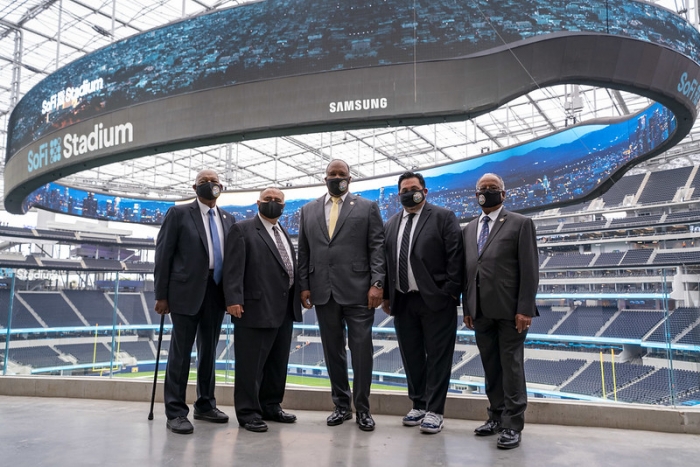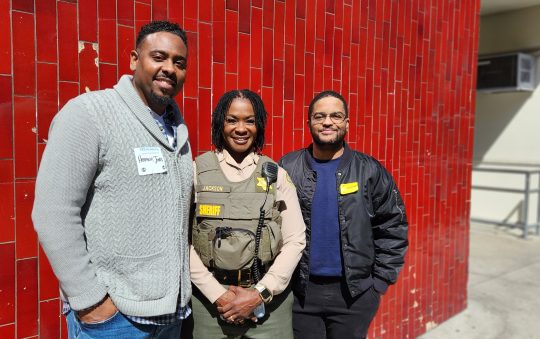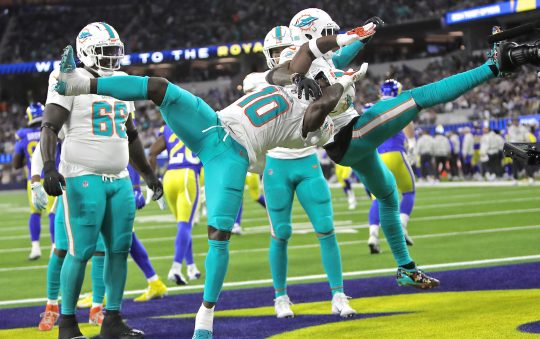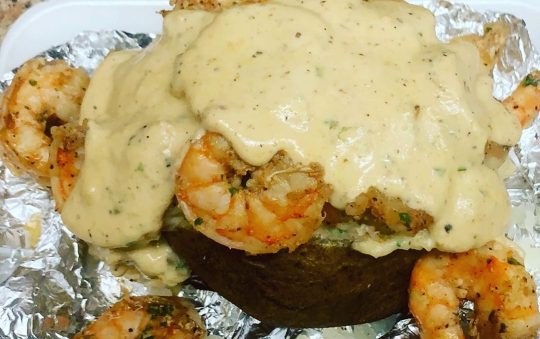
While many cities in Southern California and throughout the nation are wrestling with the economic and health impacts and fallout of the COVID19 pandemic – laying off hundreds of employees, reducing municipal services to residents and delaying the completion of long-promised projects – the city of Inglewood is a sharp study in contrast. While also managing the consequences of the pandemic and ensuring the safety of both its citizens and staff, the Inglewood economic renaissance is not only keeping its momentum, it is also gathering speed.
The world’s most famous one-day sports event, Super Bowl XVI, will take place in the new $5 billion dollar SoFi Stadium in February 2022, but that is only one of many international sporting events slated to take place in Inglewood. Others include Wrestlemania, the FIFA Soccer World Cup and the opening ceremony of the 2028 Summer Olympics.
Even in these challenging times, Inglewood’s transformation from a South Bay city that once made headlines for its economic and crime struggles has morphed into an economic powerhouse and development oasis that has attracted three professional sports teams – the Rams, the Clippers and the Chargers. It has become the home to the headquarters of the Girl Scouts of Greater Los Angeles as well as the L.A. Philharmonic’s Youth Orchestra program and its Frank Gehry-designed headquarters. Inglewood stands out as Southern California’s most remarkable story of transformation and triumph.
Beach City Chief, South Bay City Mayor
Compare Inglewood to its neighbors to the south and the west. Or simply compare it to nearby Santa Monica.
The coronavirus outbreak has shut down tourism, drying up the beach city’s two main streams of revenue, hotel bed taxes and sales taxes. At the same time, it did not heed years of warnings about is enormous pension debt, and now, with severely reduced revenues, is paying the price. Santa Monica is now looking at a $226-million shortfall by June of 2021 and has authorized the layoffs or buyouts of 373 full time employees.

By contrast, Inglewood has enough reserves to see it through this fiscal year without furloughs or layoffs. It dramatically reduced its unfunded liabilities by eliminating non-funded lifetime retiree medical program and replacing it with an employee health savings plan. With a COVID-19 vaccine in the offing, it is possible that cuts to staff and services in this South Bay city will be minimal or nonexistent. While the differences between the two cities strain direct comparisons, they do, however, have one powerful factor in common: James T. Butts.
Butts, formerly the 15 year Police Chief of Santa Monica, has been at Inglewood’s helm for the past decade, and it is under his leadership that Inglewood has flourished.
Before Covid-19, Inglewood’s unemployment rate had plunged from 17.5% to 4.7 %, and employment remains a top priority with a 35% local hiring goal for Inglewood residents for the 50,000 construction jobs scheduled over the next 7 years. This means residents will be first in line for jobs pay prevailing wages, some paying between $60-$90 per hour. Already, hundreds of people, including parolees with the Iron Workers union, have found new careers by working on SoFi Stadium.
Moreover, property values had risen more than 200% since 2012 (finally affording Inglewood residents the opportunity to build and pass on generational wealth).
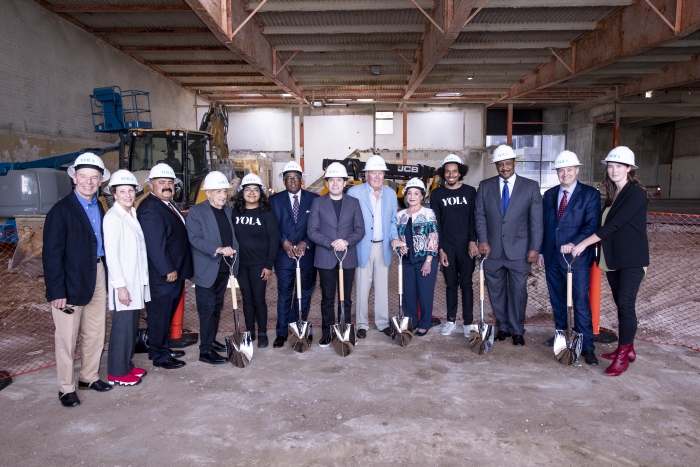
How did he do it?
Potholes, Pruning, Rock and Rap
“It began with re-opening the Forum” Butts explains. “I knew that if I could get the Forum to re-open then we would again be an attractive area for other major business entities.”
Inglewood contributed $18 million of State Redevelopment funds to re-open the doors to the city’s most famous landmark.
The question, really the gamble, was whether a major arena could succeed without a resident sports team — revenue the Forum lost when the Lakers moved to Staples Center.

The answer was an emphatic “yes.” In its first year back in operation, the renovated Forum hosted 50 paid concerts, including ones by the Eagles and the Wu-Tang Clan — almost twice as many as the Southern California area’s second-place finisher, the Verizon Wireless Amphitheater in Irvine, and double of downtown L.A.’s Staples Center.
“That put us back on the sports-and-entertainment map,” Butts said.
Simultaneously, Inglewood was laying the groundwork to negotiate with major league teams, billionaire owners and developers by paving streets, trimming trees and laying miles of fiber optic cable underground.
“It doesn’t sound very exciting but when people ask me how I did it, I tell them by paving the streets,” Butts said. “First of all, it’s what the people asked me to do when I ran for mayor. So after I got in office, we did a street survey, graded the roads from worst to best, and we have been paving them in a methodical and systematic way ever since. For our residents, this was essential. But it was also essential in order to make us business friendly.

Under Butts, the city has re-paved more street lanes, miles of roadway and fixed linear feet of sidewalk than any administration in the history of Inglewood. And Century Boulevard, Florence, Imperial Highway which were 20 years overdue was reconstructed.
Opportunity knocked once again when Stan Kroenke, the billionaire developer and owner of the Rams, drove down newly paved La Brea Boulevard to City Hall, to tell the mayor he wanted to move the Rams to Inglewood.
Deal took negotiations
Seated in the mayor’s sparsely decorated office, Stan laid out his plan and asked that Inglewood:
1. Put up $500 million in a bond because the league was going to charge him a $500 million relocation fee.
2. Entitle the north end parking of the Hollywood Park site, (which is right across the street from the Forum) for residential housing development in the event the league would not allow him to move
3. Get Stockbridge Capital to sell him 100 acres to go with the 60 acres that he had previously purchased from Walmart, because he needed about 160-170 acres for a stadium.
The mayor politely declined that deal.
“Most mayors would have fallen over themselves to bond for $500 million. Just to have a chance at a stadium,” Butts recalled, “But I said no way. Not going to do it. We weren’t interested in public financing a stadium and hoping for ancillary revenue to pay the annual bond payments. That usually doesn’t work out financially for cities as the bonds payments are structured over 30 years, with no guarantee that revenues will cover the payments.”
Moreover, Inglewood could never rezone the north parking area to be rezoned for residential housing, he told Kroenke. The Forum was entitled back in 1967 with on 3,500 parking spaces under the belief that the Hollywood Race Track would be there in perpetuity. For sellouts, that Forum needed up to 1,500 spaces across the street on the Hollywood Park site. The Forum could not operate without that space.

“I also told Stan that I did not want to take the largest contiguous block of open land in urban southern California and entitle it for a use that projected out (with one football team) to be in use less than 20 days a year.
Then the mayor laid out an alternate proposal:
He articulated the pros of building out the entire project to Stan Kroenke; “The land is less than 2 miles from one of the busiest airports in the United States and the weather is so good here, that when it rains hard, we have to buy new umbrellas because most of us forget where we put our umbrellas.”
He said; “If I were you, I would do a joint venture with Stockbridge Capital (the financial arm of Hollywood Park Tomorrow), adopt their entitlements and seek to expand it. Then you would have a revenue generating project 365 days per year. You have the 3 things it takes to bring football back to LA; you have a team, you have the money to buy land and you can likely get the votes of the League owners. You can place an football team anywhere you can buy 170 acres, but only in Inglewood can you build Kroenkeville…a mixed use development in play 365 days per year.”

Stan sat back on the couch and said; “Huh. You’re a pretty smart guy.” In less than 2 hours each man knew what the other could live with.
Let’s Make a Deal
Hollywood Park Tomorrow, a development with 75,000 square feet of office, 450,000 square feet of retail space and 2,500 residential units, and 25 acres of park space had already been entitled, back in 2007-2008, and was ready to go. But unfortunately, the recession hit, the housing market had crashed, and the project was dead. When the Forum reopened, the Stockbridge Capital group received EB-5 pledges that allowed them to go forward. So, when Kroenke approached them, Stockbridge wasn’t interested. They had been through the dance with the NFL in the 1990’s when Al Davis had negotiated a deal with Hollywood Park and the city to move the Raiders back to the LA market on that same land. Al Davis asked the city for $10 million dollars non-refundable and Inglewood declined. Al Davis would get that $10 million non-refundable from city of Irwindale. He never built a stadium in Irwindale and left with the $10 million and returned to Oakland.
“Stan called to tell me Stockbridge won’t sell and they won’t even talk about it,” the mayor said. “I said okay. Let me see what I can do.”
What the mayor would do would was use Inglewood leverage to bring the parties together.
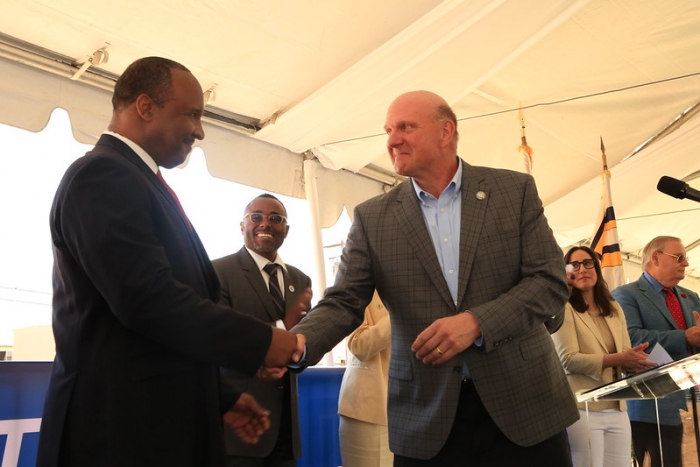
Hollywood Park Tomorrow wanted a minor modification in their development agreement; instead of having to put up a bond for the entire project as soon as they broke ground, they wanted to be able to bond piece by piece. That’s a change the mayor said he would grant – under one condition.
“I will give you the modification, but only if I feel you’ve negotiated substantially with Stan Kroenke,” Butts conditioned.
And negotiate, they did.
An initiative was put forward by an Inglewood resident. It garnered over 22,000 signatures (far more than what was required to put it on the ballot). The whole city rallied to support the stadium, by supporting the initiative that would allow the entitlements for the expanded retail and office program (the original proposal had a 70,000 seat NFL stadium cleared environmentally) without a new EIR. The City Council adopted the initiative by unanimous vote. An overwhelming majority of residents united to bring the Rams to Inglewood.
With private funds, Kroenke built SoFi Stadium as the centerpiece of a 300-acre development that is 2½ times the size of Disneyland at a cost of about $5 billion. An artificial lake will lie at the south end of the stadium and a 6,000-seat performing arts theater and a 200,000-square-foot building to house employees of the NFL Network are nearly finished.
The plan also calls for a 300-room hotel, more than a million square feet for residential, commercial and retail space and four parks.
Mayor Butts said; “Stan Kroenke’s vision that Inglewood was an overlooked jewel for the NFL’s return to the market was critical. We are forever appreciative that Stan and the NFL owners chose Inglewood over Farmers Field and the Carson stadium concept.”
Halimah Ginyard, President of the Inglewood Airport Area Chamber of Commerce said; “Stan Kroenke’s SoFi Stadium project employed over 1,200 Inglewood residents and spent over a half-billion dollars using minority led and disadvantaged businesses as local subcontractors. Stan Kroenke stood tall for Inglewood residents and small businesses….Stan even contracted with Inglewood businesses for catering of milestone construction events.”
That’s how Inglewood did what many cities across the country had tried to do, land an NFL Team. But Inglewood did it without public funds or securing municipal bond indebtedness.
“We could do it because we aren’t Los Angeles. We could do it because we are small enough to have a nimble government that cut through layers of bureaucracy.”

What did Inglewood seek in return?
1) 35% Local Hire goal
2) The developer to pay up front for the construction of both the private and public pieces of the development.
3) A hard to hire provision (Result – Over 100 convicted felons have worked on this project at prevailing wages and gained training and job skills to sustain them in the future.)
4) Construction materials wholesaled to Inglewood site – This allowed Sales taxes on materials contracts in excess of $5 million dollars to be collected by the city of Inglewood (averaged 15 million per year in additional revenue)
5) No bonding for the project by Inglewood (If Inglewood had bonded the city would have a bond payment due next year with no offsetting stadium revenue).
“We knew how great this is going to be for our residents in terms of jobs and diversifying our tax base, so we were going to make it happen — and we did it in a way that worked for the Rams and worked for Inglewood and our residents.”
Mayor Butts, who has an MBA from Cal Poly Pomona, says that it is his business background, not experience as a police chief or head of anti-terrorism at Los Angeles World Airports that has been most relevant to the business renaissance of Inglewood.
“It helps that I speak the language of business and understand the concerns those that risk large sums of capital investing in a city,” he said simply.
After the Rams came the Chargers. Then came the Los Angeles Clippers and owner Steve Ballmer, determined to build a state-of-the-art arena for his team. Massive litigation followed Ballmer’s decision, as Madison Square Garden (MSG) sought to block the Clippers from siting their headquarters in Inglewood. MSG (arranging financing of over a $1 million dollars) backed a candidate to run against the mayor (who won with more than 60% of the vote), sued the Clippers, sued the city of Inglewood and sued Butts personally.
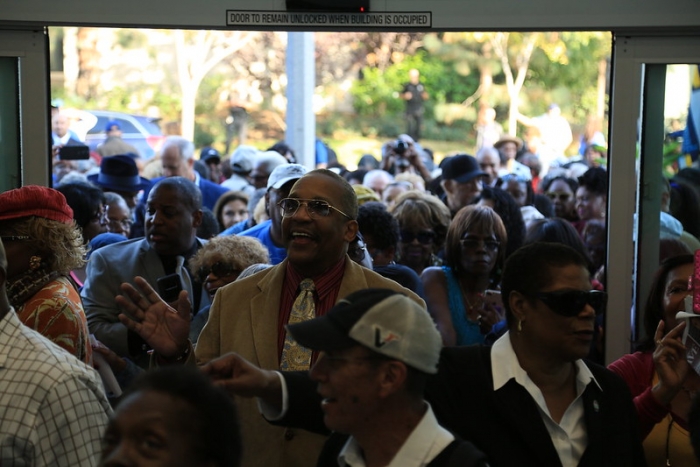
Eventually, Ballmer would write a $400 million check, purchase the Forum from MSG and all parties settled in March 2020.
Inglewood Today
Today, the key components of the renaissance are either completed or nearing completion.
Madison Square Garden has gone back to New York and the “Fabulous Forum” is now part of Ballmer’s sports and entertainment footprint in Inglewood.
SoFi Stadium is the most magnificent and technologically advanced sport structure in the world, and the Rams and the Chargers are midway through their first NFL Season in their new home.
The Clippers are edging closer to breaking ground on what will be the preeminent professional basketball arena in the world, and a practice facility, 18,000-seat NBA arena, open space and retail will take shape on land that has lain fallow for over three decades.
The NFL Network building is weeks of being ready for occupancy, and the 298-acre Hollywood Park Development is an aerial landmark for passengers approaching LAX.
In terms of quality of life, the challenges posed by COVID-19 cannot be dismissed. Real suffering has been visited on people who have lost both livelihood and loved ones.
Yet, with regard to public safety, the city continues to create a safer and more security environment.
Inglewood is in its 9th consecutive year of the lowest crime rates in its recorded history. In fact, the year 2019 holds the distinction of having the lowest level of crime in city records.
Lastly, the Inglewood Airport Area Chamber of Commerce, fittingly, is in the final stages of a renovation that will give the organization is due as a key partner in Inglewood’s economic turnaround.
“I want to be clear – I haven’t done all of this by myself. I have a talented team of City Council Members (Eloy Morales, Alex Padilla, George Dotson and Ralph Franklin) along with our City Manager Artie Fields and our dedicated Department Heads that have worked night and day to make this happen,” Butts said. “Overwhelmingly our team is made up of people who live in Inglewood, who are connected to its past, and are deeply invested in this city that we all love.”



